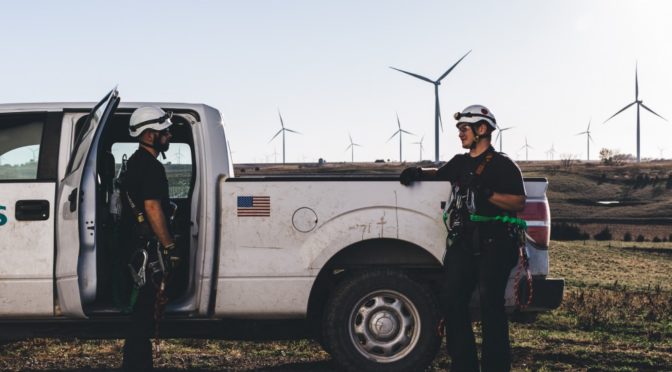The long white blades carve graceful circles through the salt air. Spinning clockwise, they slice across the impossibly blue sky that frames them.
We’ve been watching them since they crept into view, about 15 minutes after our boat left Montauk. From afar, they’re beautiful. Up close, they’re stunning.
These five wind turbines located three miles off the bluffs of Block Island are the first offshore wind farm in the United States. Constructed by Deepwater Wind, they went online in December, producing 30 megawatts of electricity for Block Island and Rhode Island.
The company’s next project is momentous. Its 90-megawatt South Fork Wind Farm about 30 miles off Montauk will be the nation’s first utility-scale wind farm. It will feed Long Island’s power-starved East End by the end of 2022, if it proceeds as planned — a showcase for the rapid growth of wind energy, a harbinger of the potential for offshore wind, in particular.
 Columnist Michael Dobie, a member of Newsday’s editorial board, on a boat ride last week to see the wind turbines located three miles off the bluffs of Block Island. Photo Credit: Sam Guzik
Columnist Michael Dobie, a member of Newsday’s editorial board, on a boat ride last week to see the wind turbines located three miles off the bluffs of Block Island. Photo Credit: Sam GuzikLong Island, a pioneer. How about that?
advertisement | advertise on newsday
Now, if you’ve seen photos of massive wind arrays in Europe and you’re thinking we’re a little behind on this side of the pond, you’re right. Europe has nearly 3,600 offshore wind turbines in 10 countries with a capacity of more than 12,600 MW. But the opportunity for catch-up is real.
The U.S. Department of Energy says the nation’s “technical” offshore wind capacity is 2,000 gigawatts. All U.S. fossil fuel plants together produce about half that. Much of that offshore wind potential is in the Northeast from Washington to Boston, says Deepwater Wind vice president of development Clint Plummer.
And Long Island is at the center. It’s also ground zero for the threat posed by rising seas, adding to the urgency to ramp up the use of renewable energy sources like wind.
When Gov. Andrew M. Cuomo set a state goal for 2,400 MW of offshore wind power by 2030, he was looking at Long Island. The South Fork farm, fully built out, could produce 2,000 MW, some for Long Island, some for New England. Other federal leases for the ocean floor off Nassau’s South Shore — one given, others in the offing — would increase that exponentially. Bigger turbines producing more power will further drop costs, but wind for now is still more expensive than fossil fuels. But cost can’t be the only consideration in the era of climate change.
Some beachgoers and coastal residents say windmills spoil their views. I don’t get it. Most of the new turbines won’t be visible from shore, but even if they did dot the horizon, they’re hardly visual pollution. They’re certainly nicer to look at than big barges.
If only Long Island were better positioned to reap more from wind’s advance than electricity. Like jobs. Wind turbine technician is one of the fastest-growing occupations in the United States. And that’s only from the rapid growth in land-based wind power. But there’s more to this puzzle.
The various parts of the Block Island turbines were fabricated in France, Denmark and Louisiana, with some assembly in Rhode Island. With all the potential work looming all around us, and with an entire industry poised to take off, why not launch it on Long Island?
Infrastructure. As in: We don’t have it. That includes a deepwater port, the one that could be built in Shoreham at the site of the decommissioned nuclear reactor. It also requires skilled labor. Deepwater Wind has agreed to use local workers for parts of its South Fork farm and train them, but how many depends on what technology it uses.
“The industry is exploding,” Plummer said, as our boat skipped back to Montauk. “Whoever can build the manufacturing facilities will have a leg up.”
That’s the challenge for our state and local leaders. Imagine, wind powering not just our homes, but our economy.
advertisement | advertise on newsday
Michael Dobie is a member of Newsday’s editorial board.
Michael Dobie
newsday.com


